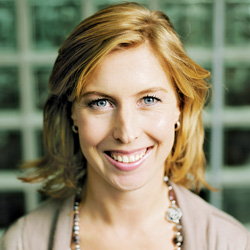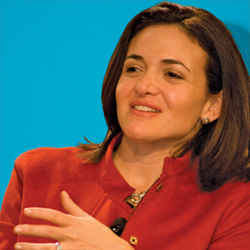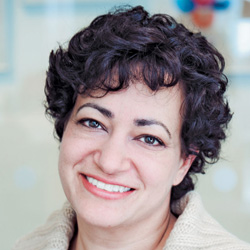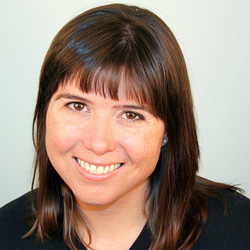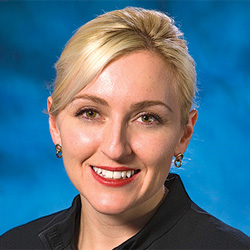The Most Important Women in Mobile Tech 2011
In the 1800s, Charles Babbage created the first mechanical computer. But it was Countess Ada Lovelace who wrote the first computer program in 1842. While women have played a critical role in technology's evolution since the beginning, they only make up between 2 and 15 percent of the C-level jobs at the top Fortune 500 IT companies. That means men account for at least 85 percent of all CEOs, CTOs, CFOs, and other top-level positions.
The lack of women in tech is a complex problem with no clear solution. But that doesn’t mean truly important females aren’t out there making a difference and shaping your mobile life. Here are 20 role models and inspirations who are changing the face of our world through their influence in the mobile tech industry.
Genevieve Bell Intel Fellow
For most people, the last place they’d expect to find a cultural anthropologist is at a chip manufacturer. But at Intel, Bell’s job is to put technology in a human context. She spends a lot of her time traveling the world, visiting social centers and people’s homes to get a real sense of how individuals use technology. Last year Intel made Bell the head of the new Interaction and Experience Research Group, which is currently developing a slate of context computing technologies that enable devices to learn and understand who we are (as much as silicon is able).
Bell grew up in an Aboriginal community in central Australia where, at a young age, she “learned to kill things,” a skill she’s since come to appreciate as “useful to have.”
Watch Bell's talk on Ethnography, Women & Technology from 2009's IntelUpgrade:
Sign up to receive The Snapshot, a free special dispatch from Laptop Mag, in your inbox.
Twitter: @ClaireBoo
Executive Profile: Layar Founders
Claire Boonstra Co-founder of Layar
Her company is barely two years old and already Claire Boonstra and her co-founders have been heralded as visionaries for setting off the augmented reality explosion. Layar's platform takes advantage of a smart phone’s built-in camera, accelerometer, compass, and GPS to locate where the user is in real life and then display layers of data on top. This info can be anything from the nearest ATM location to invisible clues in an alternate reality game. Boonstra was also one of the minds behind the “What Women Want in Mobile” platform, an initiative designed to help the mobile industry focus on the real needs of women who use tech (read: not pink gadgets).
Someday Boonstra hopes to put her civil engineering degree to use once more and build a “Boonstra bridge.”
Website: LisaBrewster.com
Twitter: @Adora
Lisa Brewster Developer relations administrator, HP-Palm
Openly admitting on her website that she is “passionate about recording and sharing life’s little details,” Lisa Brewster proves her dedication with the microflashes of her life that spill out via Flickr, Tumblr, Twitter, and her personal wiki. Now she has to convince those making apps to become passionate about webOS, as HP and Palm try to jumpstart the platform. With the tech world impatiently awaiting webOS tablets and a wave of new smart phones to compete against iOS and Android, Brewster’s goal of making developers “feel like they’re part of something awesome” will be key.
Brewster has been an avid photographer for more than 10 years.
Leah Buechley Assistant professor at the MIT Media Lab, director of the High-Low Tech Group
Her research has already led to the development of T-shirts that work as instruments, interactive wallpaper that monitors its surroundings, and sewable electronic components that allow individuals to build their own wearable, interactive fashion. Leah Buechley is in the enviable position of educating some of the brightest students in the country while collaborating with them on amazingly cool mashups of textiles and technologies. This tech has already found its way into novelty items, but the ideas Buechley germinates may just lead to a future where your sleeve is also your smart phone.
Buechley’s research in the field of electronic textiles earned her the Best Paper award at the 2006 International Symposium on Wearable Computers.
Twitter: @shaherose
Executive Profile: Women 2.0 Founders
Shaherose Charania CEO and co-founder, Women 2.0
In 2006, Shaherose Charania moved from Vancouver to the Bay Area with just two backpacks and a desire to apply her instincts and skill for helping entrepreneurs. That year she co-founded Women 2.0, a group dedicated to increasing the number of successful female-founded startups through a strong network and plenty of resources. The company’s events and seminars attract leaders in startup incubation, angels, and venture capital firms. A self-professed telephony junky and Mobilista, Charania is particularly interested in using mobile technology to change the world by bringing its benefits to emerging markets.
Prior to moving to the Bay Area and co-founding Women 2.0, Charania spent a year living in Spain.
Website: New DivaBlog
Twitter: @DivaDanese
Danese Cooper CTO, Wikimedia Foundation
As the only female CTO of a website ranked in the top 10, Danese Cooper is charged with keeping Wikipedia on the cutting edge as it enters its second decade. As the Wikimedia Foundation’s chief technology officer, Cooper is responsible for the organization’s technical strategy, which includes driving innovation and developing the wiki software behind Wikipedia. The organization anticipates that more users will access Wikipedia’s mobile site than the desktop version in the years to come, and a large part of Cooper’s job will be to ensure that the underlying code is open enough to spread the knowledge contained within the site’s millions of articles to every device with (or without) a connection.
Cooper graduated from UCLA with a B.A. in French Literature. She’s convinced that learning a language helped form the neural pathways that eventually helped her learn programming.
Weili Dai Co-founder and Vice President and General Manager of Communications and Consumer Business, Marvell
Though you may not know it, Marvell’s products probably drive at least one of the pieces of technology you own. Maybe it’s the processor in your eReader, the wireless radio in your phone, or the hard drive in your laptop. And Weili Dai has been instrumental in driving Marvell from the very beginning. She immigrated to the U.S. to study at Berkeley, and in 1995 she co-founded Marvell with her husband and brother-in-law. Since then she’s helped build the company into one of the world’s largest semiconductor players.
The University of California, Berkeley named the Sutardja Dai Hall for Dai and her husband, Sehat Sutardja, for their long-term contributions to the university and commitment to education.
Executive Profile - U. S Cellular
Mary N. Dillon CEO, U.S. Cellular
Last summer when U.S. Cellular named Mary N. Dillon as their president and CEO, she became the first woman to fill that role for a wireless carrier. In her first week on the job, Dillon met with employees in retail stores and call centers, a practice she started at Quaker Foods. Now she’s trying to grow the country’s sixth largest service provider, which serves more than 6 million customers in 26 states throughout the Midwest. Dillon's team made a big splash in September with the Belief Project, which encourages customer loyalty with “One and Done” contracts, a rewards program with points that don’t expire, phone replacements (even for handsets not under warranty), and overage protection.
Dillon is an accomplished amateur athlete, having completed a marathon and two triathlons.
Blog: All About Microsoft
Twitter: @maryjofoley
Mary Jo Foley Technology journalist
Mary Jo Foley has been covering technology for more than 25 years and Microsoft specifically for at least 10—a long time to keep an eye on one of the country’s top tech behemoths. Her insights into the company and the tech industry at large have made her the go-to woman for commentary on ABC Radio, BBC, CNBC, CNN, and NPR. In 2001 she moved from exclusively print-based punditry to the blogging world. She currently pens the All About Microsoft blog for ZDNet.
When she was starting out as a tech journalist, Foley was interviewing Bill Gates at the now-defunct Comdex show in Las Vegas when Steve Jobs came up and began chatting with Gates. Foley asked Jobs to come back later as she was in the middle of an interview; it wasn’t until Jobs walked away that she realized he was the head of Apple.
Executive Profile: Pixel Qi - About Us
Mary Lou Jepsen Founder and CEO, Pixel Qi
After developing a sunlight-readable LCD display for One Laptop Per Child’s XO PC, Dr. Jepsen spun the technology she’d developed into a company of her own: Pixel Qi. The company’s low-power, dual-mode displays have already come to market as upgrade kits, and this year they’re set to revolutionize devices from tablets to mobile phones to eReaders. Dr. Jepsen’s 3Qi screens use a fraction of the power of traditional battery-hogging LCD, and have the ability to display a full range of color plus an ePaper-like reflective display that uses ambient light.
While working on her Ph.D. in Optical Sciences at Brown, Jepsen worked out the fundamental engineering and logistical issues for projecting images onto the largest display to date: the dark side of the moon.
Company Profile - Boston Power
Dr. Christina Lampe-Onnerud Founder and CEO, Boston Power
Instead of just throwing more cells at everything or packing in so much power that your mobile tech turns into a potential explosive, Dr. Christina Lampe-Onnerud and her team at Boston Power have redesigned Li-ion batteries from the inside out, rethinking everything from the shape of cells to how the current flows. Her innovations have resulted in safer batteries that charge faster, boast a longer life cycle, and are much friendlier to the environment than traditional Li-ion. The company’s first battery, the Sonata, has already made its way into notebooks from major manufacturers, such as ASUS and HP. Next up: cars.
Dr. Lampe-Onnerud is an accomplished cellist, jazz dancer, and choral director.
Twitter: @marissamayer
Marissa Mayer Vice president of geographic and local services, Google
If you’ve used any of Google’s most popular services—Search, Gmail, Maps, Earth, iGoogle—then you mostly have Marissa Mayer to thank for the clean and eminently usable user interface. One of Google’s first 20 employees and the first female engineer hired by the company, Mayer has been key to Google’s success almost from the very beginning. Since 2006 she’s been a highly visible spokesperson for the company, and until October of last year she held the title of vice president of search products and user experience. Now she oversees geographic and local services and holds a seat on Google’s operating committee/executive management group. There’s a lot to juggle in this area, but of course mobile search and contextual discovery (“search without search,” as Mayer identifies it) will be a major focus.
Mayer is the youngest person ever to make Fortune’s list of Top 50 Most Powerful Women in the World.
Website: Stormy's Corner
Twitter: @storming
Stormy Peters Head of developer engagement, Mozilla
If you’re not a free and open source software geek, you may have never heard of Stormy Peters, but her work with the GNOME Foundation Advisory Board was important in making Linux distributions such as Ubuntu Linux palatable to people accustomed to Windows or OS X. Last November she moved on to another open source project: Mozilla, the company behind the popular Firefox browser. As head of the Developer Engagement Program, Peters will ensure developers “have the tools and knowledge they need to create applications on the open web.” With Firefox finally making strides in mobile phones as well as on the desktop, Peters has plenty of work ahead of her.
Peters created and managed the HP Open Source Program office for more than five years, blending commercial interests with open source philosophies.
Profile: Facebook Executive Bios
Sheryl Sandberg COO, Facebook
When people think of Facebook, many think of Mark Zuckerberg or that Aaron Sorkin movie, but they should also take note of COO Sheryl Sandberg. The soaring success of the site required vision, but keeping the success going—and figuring out a way to monetize it and make a profit—took a skilled operations officer. That’s where Sandberg came in. In 2008 Zuckerberg hired her away from Google, where she built the AdWords and AdSense programs, and tasked her with making his social network a financial success. Since then she’s kicked Facebook revenue growth into high gear, instituting initiatives that leverage the data the network’s 500 million plus users share willingly every day. The result? Revenues were up approximately $400 to $500 million in 2009 over 2008, according to industry estimates. 2010 revenues are estimated to be as high as $2 billion.
And Sandberg isn’t done yet. Last year she told TechCrunch’s Michael Arrington that, even though Facebook is a nimble company, she’d like to see faster product generation and a shorter path from development to services and features that are ready for public consumption. So don’t look for Facebook or Sandberg to rest on their laurels any time soon.
Sandberg was one of the speakers at TEDWomen in December 2010, where she gave advice to women who want to stay in the workforce and reach the top of their chosen industries. Watch it below:
Website: CShipley.com
Executive Profile: Guidewire Team
Chris Shipley Chairman and CEO, Guidewire Group
For more than 13 years, Chris Shipley was the woman behind the DEMO Conference program, which gave emerging companies six minutes to wow a crowd of investors, analysts, and press. Over that span she helped bring more than 1,500 breakthrough products to market, including TiVo, VMWare, and WebEx. Now Shipley is the leading force behind the research firm Guidewire Group, which she co-founded in 2004 to help emerging companies successfully implement their ideas. Considering her unmatched ability to analyze the usefulness of technologies and how a given product will impact people’s lives, you could call Shipley the ultimate influencer.
Shipley sits on the board of directors for the Forum for Women Entrepreneurs and Executives.
Executive Profile: Canonical Management Team
Jane Silber CEO, Canonical Ltd.
A little less than a year ago, Jane Silber stepped into the CEO role at Canonical, the privately backed company behind the popular open source Ubuntu Linux distribution. She has to maintain the delicate symbiotic relationship between the corporation and the operating system’s community of open source developers. In an interview, she described the company and its ecosystem as being “like a living animal.” Thanks to Silber’s leadership, Ubuntu continues to grow both as an enterprise/server solution and a viable OS for the desktop with developments such as the Ubuntu One cloud syncing program, Unity interface for netbooks, Ubuntu Light for instant-on, dual-boot installations, and the introduction of multitouch capability in the OS.
Before joining Canonical, Silber conducted artificial intelligence research for a company in Yokohama, Japan.
Website: GinaTrapani.org
Twitter: @ginatrapani
Gina Trapani Blogger, programmer, entrepreneur
Blogger, author, programmer, entrepreneur; Gina Trapani is the embodiment of the Web 2.0 renaissance woman who hacks life with the same relish as she hacks computers. In 2005 she founded the award-winning Lifehacker blog, which she led until 2009. Shortly after signing up for Twitter in 2007, she began development on a project that eventually became ThinkUp, an open source web app that helps individuals and businesses search, sort, filter, export, and visualize social media data and conversations in meaningful ways. Currently, she works as a project director at Expert Labs to develop this app for the White House, among other clients. Additionally, Trapani blogs for Fast Company, Smarterware, and Scribbling.net, co-hosts the This Week in Google video podcast, and develops Android apps and Firefox add-ons... for fun.
Fast Company named Trapani one of the Most Influential Women in Technology in 2009 and 2010.
Cher Wang Co-founder and chairwoman of HTC and VIA Technologies
How does one become the fifth richest person in Taiwan? Cher Wang did it by co-founding not one, but two highly successful technology companies before the age of 40. Her second company, HTC, has always been a pioneer in the handheld space—it was first to introduce a color palm-size PC back in 1999 under the iPaq brand—but is now one of the best-known brands in the wireless space. Development of ahead-of-its-time tech is standard at HTC, including the 7-inch, Windows-powered HTC Shift in 2007 and the acclaimed Sense interface for Android devices. Though she eschews the limelight, Wang remains a vital part of both HTC and VIA as chairperson, spurred on by her love of gadgets and insatiable appetite for innovation.
Success runs in Wang’s family; her father, Wang Yung-ching, was ranked as the second richest person in Taiwan in 2008.
Twitter: @Padmasree
Padmasree Warrior CTO, Cisco Systems
Back in 2007, Padmasree Warrior (then chief technology officer at Motorola) predicted that by 2012 mobile devices “will become an extension of your persona,” with the ability to recognize your preferences and behaviors. Warrior not only predicted the future; she'd helping to make it happen. She joined Cisco as its CTO in 2008, and Warrior also serves as the senior vice president and general manager of the Enterprise, Commercial and Small Business Development Group, leading a team of 10,000 engineers. Warrior has long worked toward making seamless mobility a reality—not only by connecting everyone in the world via mobile devices, but by crafting the networks they run on to enable uninterrupted access to what’s important.
Aside from her work at Cisco, Warrior lends her time and talent to the Museum of Science and Industry, furthering education in math, science, and engineering.
Christy Wyatt Corporate vice president of software applications and ecosystem, Motorola
Before Google’s mobile operating system came along, Motorola aggressively pursued Mobile Linux on phones. But once Android entered the public’s consciousness, Wyatt spearheaded a change in course. She has cultivated a strong community of developers who are not only innovating around Android, but also Motoblur, Motorola’s custom interface for Android devices. Given her background in successful developer relations at Apple and Palm, this comes as no surprise. And now that the mobile division has been split into an independent company, Wyatt has even more opportunity to show that Motorola Mobility Holdings can reach even greater heights.
Wyatt serves on the Linux Foundation’s board of directors.
K. T. Bradford writes about laptops, apps, and ebook readers for Laptop Mag. She has written reviews of some of the most iconic laptops from the last decade and more, covering models such as the Acer Aspire One, the Samsung R580, and the Lenovo IdeaPad S205. Some of her other reviews include MSI, HP, Dell, and Asus notebooks.



